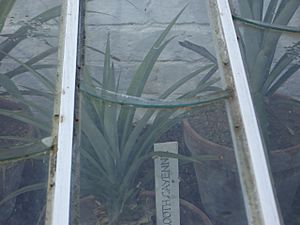Pineapple pit facts for kids

A pineapple pit is a special way to grow pineapples in places that are usually too cold for them. Imagine growing a tropical fruit in a chilly country like England! One of the first pineapple pits in Britain was found by archaeologists at a place called Heligan in Cornwall. People first grew pineapples in Europe in the Netherlands. It wasn't until around 1715 that they started growing them in England.
How a Pineapple Pit Works
A pineapple pit was like a special greenhouse built partly underground. It had three long ditches, called trenches, covered with glass. The two outer trenches were filled with a lot of fresh horse manure. As the manure broke down, it created heat. This warm air moved through small openings at the bottom of the walls. It then rose up and went through more openings at the top of the walls. This hot air flowed into the middle trench. The pineapples grew in this central trench, kept warm by the heat from the manure.
Why Pineapple Pits Were Stopped
Keeping a pineapple pit running needed a huge amount of fresh manure. It also required a lot of hard work to keep the central trench warm. Later, steam ships became common. These ships made it much cheaper to bring pineapples from warmer countries overseas. Because of this, growing pineapples in pits in the UK became too expensive and unnecessary.
Modern Pineapple Pits
An old pineapple pit was found at the Lost Gardens of Heligan in the UK. In 1993, experts like John Nelson, John Chamberlain, and Peter Thoday restored it. The original design was created by Thomas Andrew Knight. Today, this renovated pit grows two types of South African pineapples: the Jamaica Queen and the Smooth Cayenne. In 1997, the first pineapple was successfully grown there. The second pineapple grown in the pit was given to Queen Elizabeth II of the UK.

